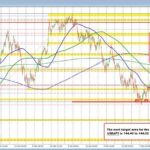
Navigating Inflation Risks: Insights from the Federal Reserve’s Latest Address
Tháng 4 3, 2025
USDJPY Forecast: Navigating Market Volatility in April 2025
Tháng 4 3, 2025Unpacking the Impact of President Trump’s Tariff Announcement on Global Markets
President Donald Trump has once again made headlines with his recent declaration of sweeping tariffs on goods imported from the European Union and several Asian countries. This bold move has had immediate ramifications for the stock markets, causing a noticeable downturn as investors reacted to anticipated economic shifts. Yet, amidst the chaos, President Trump declared that the stock market will ultimately “boom” in the future. This contradiction underscores a significant degree of uncertainty surrounding the global economy, raising concerns about inflation and recession risks.
Economic Consequences of the New Tariffs
The tariffs introduced by President Trump are expected to have profound economic implications, both domestically and internationally. Critics suggest that such actions could potentially damage the U.S. economy, slashing growth prospects while simultaneously driving inflation rates higher. With the average U.S. tariff rate projected to exceed 20%, this would mark the highest rate seen in over a century, according to experts. As a direct consequence, analysts are reconsidering their GDP growth forecasts for 2025 and 2026, with heightened recession risks now on the table. Understanding these pitfalls can be crucial for investors; for a comprehensive guide on avoiding investment mistakes in such turbulent times, consider reading the insightful article on top investment mistakes to avoid in 2023.
Furthermore, the new tariffs have raised alarm about a ripple effect in global markets. As companies adapt to increased costs, consumers may face higher prices, leading to reduced spending power. This cycle can stifle economic growth and provoke a slowdown in consumer confidence—key components necessary for sustained economic health.
Market Response: A Volatile Landscape
The stock market response to Trump’s tariff announcement has been nothing short of dramatic. Major corporations that heavily rely on imported goods, such as Apple, Nike, Amazon, and Gap, experienced significant declines in their stock prices. Investors are left to grapple with the uncertainty of how these tariffs will impact earnings and long-term strategies for companies dependent on global supply chains. This situation is reminiscent of the broader impacts discussed in relation to the ongoing U.S.-China trade tensions; for an in-depth analysis on China’s strategic moves amidst these discussions, check out this article on three strategic moves by China.
What’s more, tightening or loosening of monetary policy could influence market behavior moving forward. Given the rising economic challenges brought on by the tariffs, analysts speculate that the Federal Reserve may be driven towards a more accommodative stance, potentially resulting in interest rate cuts. This shift could provide some relief for businesses and consumers alike, although it also opens the door to further complications, including inflationary pressures.
Trump’s Optimism Amidst Market Chaos
Amid a backdrop of rising uncertainty and volatility, Trump continues to express optimism about the future performance of the market. His belief in an eventual market “boom” seems at odds with the immediate realities facing investors and the economy at large. This optimistic outlook raises questions about the feasibility of achieving long-term economic stability in a climate characterized by protectionist policies and trade tensions.
In summary, President Trump’s announcement of sweeping tariffs has sent shockwaves through global markets, creating an environment of heightened tension and concern. The potential for increased inflation and a shift in economic growth trajectories poses challenges that both businesses and policymakers must navigate. As investors watch for signs of recovery, the long-term consequences of these tariffs remain uncertain, warranting close attention in the months to come. The intersection of policy and market psychology will undoubtedly shape the landscape of the U.S economy as we approach the conclusion of 2023 and beyond. For those interested in the technical details of key currency movements in light of these economic changes, insights on the GBP/USD trading strategies can be found here.

